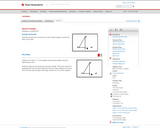
Filled in notes with vocabulary and example problems with radical equations.
- Subject:
- Mathematics
- Material Type:
- Activity/Lab
- Provider:
- College of Southern Nevada
- Date Added:
- 02/12/2018

Filled in notes with vocabulary and example problems with radical equations.

This lesson provides students the best possible methods for solving equations that contain a radical.

Guided notes for class use with vocabulary on solving radical equations.

Worksheet with answers that solves rational functions and determines extraneous solutions.

This video solves the equation sqrt(3x-7)+sqrt(2x-1)=0, only to find out that the single solution is extraneous, which means the equation has no solution.

Students learn if-then moves using the properties of equality to solve equations. Students also explore moves that may result in an equation having more solutions than the original equation.

Students examine the relationships created by special lines in triangles, namely, midsegments.

Students understand that the altitude of a right triangle from the vertex of the right angle to the hypotenuse divides the triangle into two similar right triangles that are also similar to the original right triangle. Students complete a table of ratios for the corresponding sides of the similar triangles that are the result of dividing a right triangle into two similar sub-triangles.

Interactive PPT class game applying special triangle properties.

Worksheet with practice problems on special triangles.

Class guided notes with practice on the rules of special right triangles.

In this Khan Academy activity, students will find use the properties of special right triangles to answer problems.

This video explains how a 45-45-90 triangle works.

This video explains 30-60-90 trangle relationships.

Texas Instruments activity using the properties of special right triangles.

Worksheet solving square root equations

This lesson will explain statistical significance.

In this lesson the vertical stretching or squishing of a function on a graph is demonstrated.

In this lesson the horizontal stretching or squishing of a function on a graph is demonstrated.

Students extend what they learned in Module 3 about how multiplying the parent function by a constant or multiplying the x-values of the parent function results in the shrinking or stretching (scaling) of the graph of the parent function and, in some cases, results in the reflection of the function about the x- or y-axis.